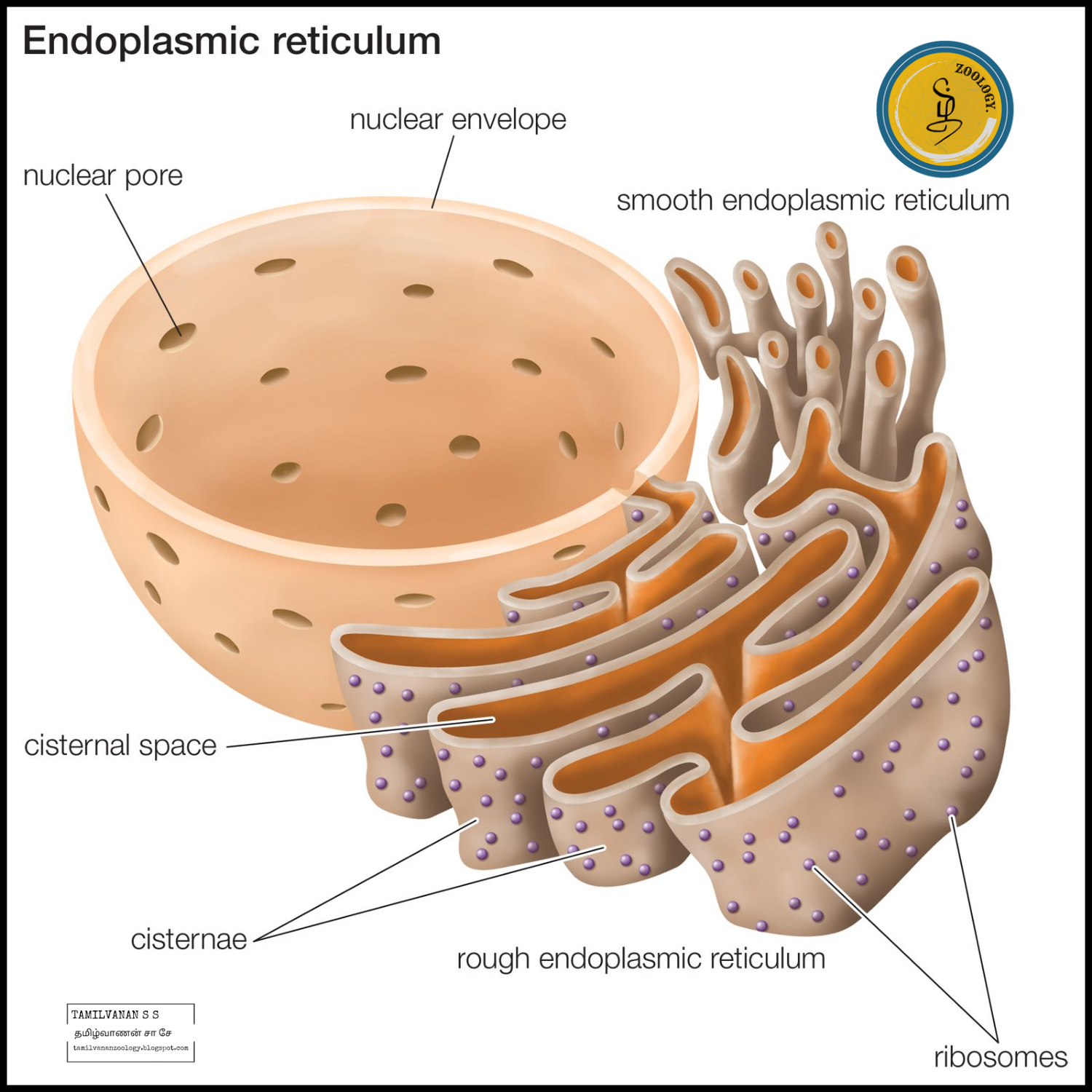Introduction
The endoplasmic reticulum (ER) is a vital organelle present in eukaryotic cells, with membranous structures that extend throughout the cell and carry out various cellular processes. The Endoplasmic Reticulum is of two types: the rough endoplasmic reticulum (RER), with ribosomes on its surface, and the smooth endoplasmic reticulum (SER), which lacks ribosomes.
Definition
Endoplasmic Reticulum is a large organelle that consists of a network of membrane and tubular structures whose primary functions include the formation, packaging, and secretion of numerous cellular products.
Endoplasmic Reticulum
The endoplasmic reticulum consists of an extensive network of membranous tubules and flattened sacs known as cisternae, which is present in the cell’s cytoplasm. It is the largest single structure present in the eukaryotic cell that originates in close proximity to the nucleus and extends throughout the cell.
Prokaryotes and red blood cells lack any kind of ER. The ER is linked to other cellular organelles and contributes significantly to the functioning and survival of eukaryotic cells by allowing various functions like protein folding, lipid metabolism, etc.
The ER plays a vital role in various cellular processes, with its two primary forms: the rough endoplasmic reticulum (RER) and the smooth endoplasmic reticulum (SER).
The RER is characterized by its rough appearance due to the presence of ribosomes on its surface and is mainly involved in protein synthesis. The smooth ER, lacks ribosomes, and is responsible for lipid synthesis, drug detoxification, and calcium ion storage.
Diagram of Endoplasmic Reticulum
The Diagram of Endoplasmic Reticulum is as follows:
Structure of Endoplasmic Reticulum
The detailed structure of endoplasmic reticulum is as follows:
The endoplasmic reticulum membrane is 50 to 60 A° thick and fluid-mosaic, similar to the plasma membrane unit membrane.
The endoplasmic reticulum membrane is continuous with the plasma membrane, nuclear membrane, and Golgi apparatus membranes.
The endoplasmic reticulum contains cavity which act as a passage for secretory products.
The ER take three different forms as follows:
1.Vesicle
2.Cisternae
3.Tubules
Vesicles
Vesicles are small, membrane-bound sacs produced by the ER and can bud off from the ER and fuse with other organelles or the cell membrane, allowing material exchange.
It help in transporting various cellular materials, including proteins and lipids, to specific site within the cell.
Cisternae (cisterns)
Cisternae are flattened, sheet-like structures within the ER and form a network of interconnected membranes.
In the smooth endoplasmic reticulum (SER), cisternae are involved in lipid synthesis, drug detoxification, and calcium ion storage.
It act as the main sites for protein synthesis, folding, and modification in the rough endoplasmic reticulum (RER).
Tubules
Tubules are long, cylindrical structures that make up part of the ER network and provide flexibility to the ER structure.
These tubules are involved in the extension and connection of the ER throughout the cell and facilitate the movement of materials within the organelle.
Types of Endoplasmic Reticulum
There are two types of Endoplasmic reticulum present based on the presence of ribosomes:
Rough Endoplasmic Reticulum
The RER is made up of phospholipid bilayers, similar in structure to the cell’s plasma membrane.
RER have ribosomes attached to its cytoplasmic surface. These ribosomes are involved in protein synthesis.
The membranes of the RER have number of flattened sacs called cisternae, which are interconnected and allow the exchange of material and information.
Inside the cisternae is a central space or lumen which serves as a site where protein synthesis, folding, and modification occur.
After synthesis and modification, proteins are packaged into transport vesicles. These vesicles bud off from the RER and carry the proteins to their respective destinations within or outside the cell.
Smooth Endoplasmic Reticulum
The SER shares a similar membranous structure with the RER, consisting of a network of tubules and cisternae. However, it lacks ribosomes on its surface, giving it a smooth appearance.
A main function of the SER is lipid synthesis and produces phospholipids and steroids, which are essential components of cell membranes.
The SER contains enzymes involved in detoxifying drugs and toxins.
The SER is responsible for storing and releasing calcium ions (Ca2+). These ions play pivotal roles in various cellular processes, including muscle contraction, cell signaling, and enzyme activation.
The SER is involved in various metabolic processes and can serve as a storage site for certain molecules, such as glucose.
Functions of Endoplasmic Reticulum
The endoplasmic reticulum plays essential roles in protein and lipid synthesis, detoxification, calcium ion storage, and various metabolic processes, contributing significantly to the proper functioning of eukaryotic cells. The functions of Endoplasmic Reticulum is as follows:
Ribosomes attached to the RER’s surface synthesize proteins, particularly those destined for secretion, incorporation into cell membranes, or specific organelles.
Proteins entering the RER’s lumen undergo proper folding and post-translational modifications, including glycosylation, to ensure their functionality.
The RER packages synthesized proteins into transport vesicles, which bud off and transport the proteins to their appropriate cellular destinations.
The SER is primarily responsible for synthesizing lipids, including phospholipids and steroids, which are essential components of cell membranes and serve various cellular functions.
It contains enzymes involved in the detoxification of drugs and toxins by chemically modifying them to enhance water solubility and facilitate excretion.
The SER stores calcium ions (Ca2+), which are crucial for muscle contraction, cell signaling, and enzymatic activities. It participates in the regulation of cellular calcium levels.




